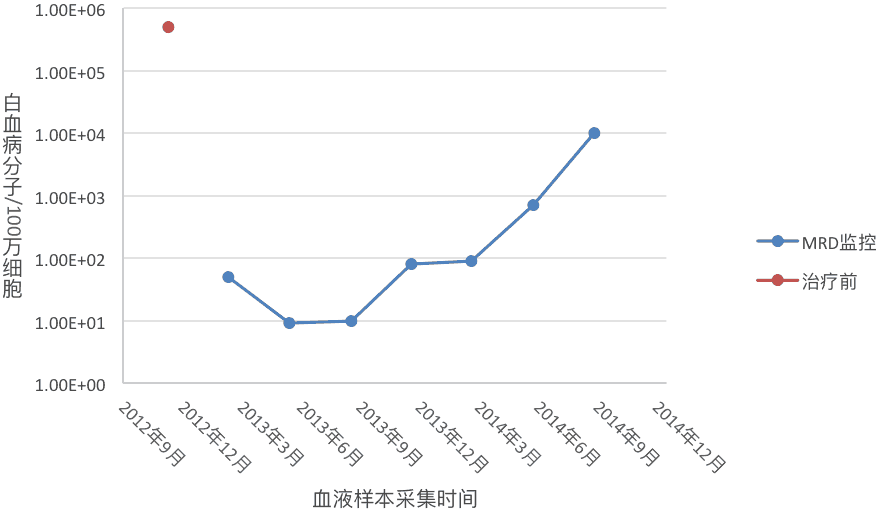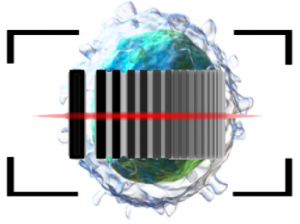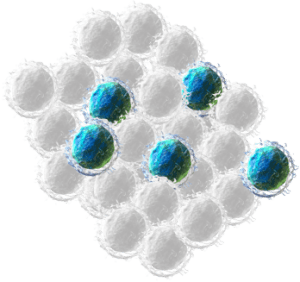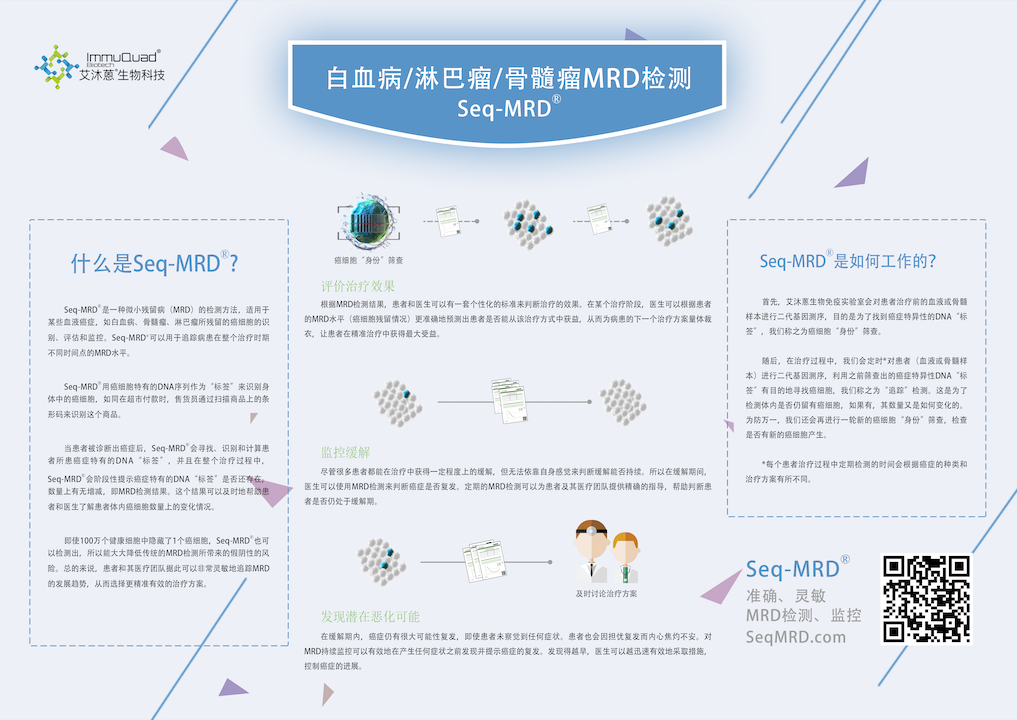Seq-MRD®
什么是Seq-MRD®?
Seq-MRD®是一种微小残留病(MRD)的检测方法,适用于某些血液癌症,如白血病、骨髓瘤、淋巴瘤所残留的癌细胞的识别、评估和监控。Seq-MRD®可以用于追踪病患在整个治疗时期不同时间点的MRD水平。
Seq-MRD®用癌细胞特有的DNA序列作为“标签”来识别身体中的癌细胞,如同在超市付款时,售货员通过扫描商品上的条形码来识别这个商品。
当患者被诊断出癌症后,Seq-MRD®会寻找、识别和计算患者所患癌症特有的DNA“标签”,并且在整个治疗过程中,Seq-MRD®会阶段性提示癌症特有的DNA“标签”是否还存在,数量上有无增减,即MRD检测结果。这个结果可以及时地帮助患者和医生了解患者体内癌细胞数量上的变化情况。
即使100万个健康细胞中隐藏了1个癌细胞,Seq-MRD®也可以检测出,所以能大大降低传统的MRD检测所带来的假阴性的风险。总的来说,患者和其医疗团队据此可以非常灵敏地追踪MRD的发展趋势,从而选择更精准有效的治疗方案。

Seq-MRD®检测适用的疾病
如果您有以下种类的癌症,请向您的医生确定Seq-MRD®是否对您适用。
Seq-MRD®是如何工作的?
Seq-MRD®是如何帮助您的?
评价治疗效果
根据MRD检测结果,患者和医生可以有一套个性化的标准来判断治疗的效果。在某个治疗阶段,医生可以根据患者的MRD水平(癌细胞残留情况)更准确地预测出患者是否能从该治疗方式中获益,从而为病患的下一个治疗方案量体裁衣,让患者在精准治疗中获得最大受益。
监控缓解
尽管很多患者都能在治疗中获得一定程度上的缓解,但无法依靠自身感觉来判断缓解能否持续。所以在缓解期间,医生可以使用MRD检测来判断癌症是否复发。定期的MRD检测可以为患者及其医疗团队提供精确的指导,帮助判断患者是否仍处于缓解期。
发现潜在恶化可能
在缓解期内,癌症仍有很大可能性复发,即使患者未察觉到任何症状。患者也会因担忧复发而内心焦灼不安。对MRD持续监控可以有效地在产生任何症状之前发现并提示癌症的复发。发现得越早,医生可以越迅速有效地采取措施,控制癌症的进展。

使用Seq-MRD®作为您MRD监控手段
二代测序方法作为新兴的MRD检测方法,也已受到国内外专家认可并推荐。2017年版国际临床实践指南(NCCN)、2016年版《中国成人急性淋巴细胞白血病诊断与治疗指南》和2017年版《中国多发性骨髓瘤诊治指南》均推荐高通量测序(NGS)作为MRD检测方法。
参考文献:
-
Predictive value of next-generation sequencing-based minimal residual disease after CAR-T cell therapy. Bone Marrow Transplant 57, 1350–1353, 2022
-
Referenced with permission from the NCCN Clinical Practice Guidelines in Oncology [NCCN Guidelines®] for Multiple Myeloma V.3.2017. ©National Comprehensive Cancer Network, Inc. 2017. All rights reserved. Accessed May 11, 2017
-
High-Throughput Sequencing Detects Minimal Residual Disease in Acute T Lymphoblastic Leukemia. 16 May 2012 Vol 4 Issue 134 134ra63
-
Deep-sequencing approach for minimal residual disease detection in acute lymphoblastic leukemia. Blood. 2012;120:5173-5180.
-
Detection of Minimal Residual Disease Using Next Generation Sequencing for Antigen Receptor Gene Rearrangements in Acute Lymphoblastic Leukemia. Clinical Lymphoma, Myeloma & Leukemia June 2015, 105
-
Immunoglobulin and T cell receptor gene high-throughput sequencing quantifies minimal residual disease in acute lymphoblastic leukemia and predicts post- transplantation relapse and survival. Biol Blood Marrow Transplant. 2014;20:1307-1313.
Next-generation sequencing and real-time quantitative PCR for minimal residual disease detection in B-cell disorders. Leukemia. 2014;28:1299-1307.
- High-throughput sequencing detects minimal residual disease in acute T lymphoblastic leukemia. Sci Transl Med. 2012;4:134ra163.
- Minimal residual disease quantification using consensus primers and high-throughput IGH sequencing predicts post-transplant relapse in chronic lymphocytic leukemia. Leukemia. 2013;27:1659-1665.
- Minimal residual disease in acute myeloid leukaemia. Nat Reviews Clin Oncol. 2013;10:460-471.
- The predictive strength of next-generation sequencing MRD detection for relapse compared with current methods in childhood ALL. BLOOD, 20 AUGUST 2015 x VOLUME 126, NUMBER 8
- Minimal residual disease diagnostics in acute lymphoblastic leukemia: need for sensitive, fast, and standardized technologies. Blood. 2015;125(26):3996-4009.
- Fast multiclonal clusterization of V(D)J recombinations from high-throughput sequencing. BMC Genomics. 2014; 15:409.
- Minimal Residual Disease in Acute Myeloid Leukemia—Current Status and Future Perspectives Current Hematologic Malignancy Reports, 2015, Page 1



